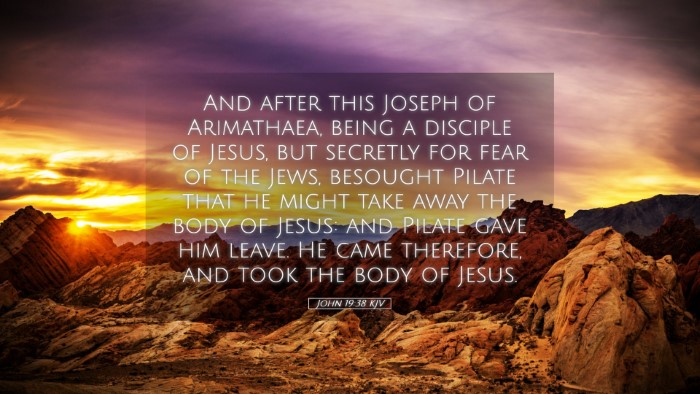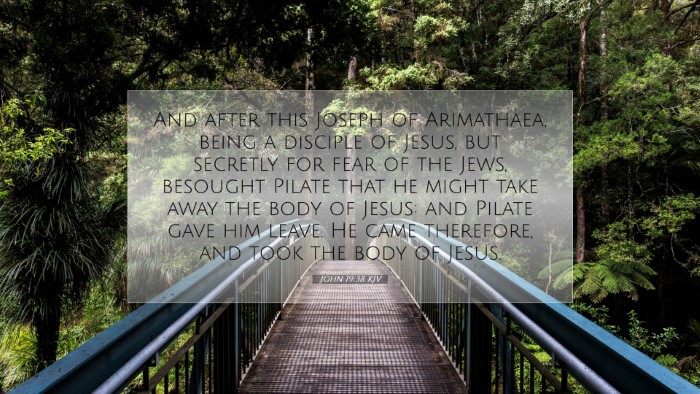Commentary on John 19:38
John 19:38 states: "After this Joseph of Arimathea, being a disciple of Jesus, but secretly for fear of the Jews, besought Pilate that he might take away the body of Jesus: and Pilate gave him leave. He came therefore, and took the body of Jesus."
Contextual Background
This passage occurs in the later narrative of Jesus' crucifixion, presenting a pivotal moment as the body of Christ is handled by Joseph of Arimathea. This section of John's Gospel emphasizes the fulfillment of prophecy and sheds light on the discipleship of Joseph, who, despite his initial secretiveness, plays a vital role in the burial of Jesus.
Insights from John 19:38
Joseph of Arimathea
Joseph of Arimathea is introduced as a significant figure in the burial narrative of Christ. Matthew Henry notes that he was a rich man and a member of the Sanhedrin, which adds weight to his actions, reflecting his courage to oppose the prevailing sentiments of the Jewish leadership of the time.
Secret Discipleship
John emphasizes that Joseph was a discipleship figure but did so "secretly for fear of the Jews." Adam Clarke points out that this fear did not negate his belief in Christ; rather, it reveals the complex dynamics of faith amid societal pressures. His secret discipleship highlights the inner struggle many believers face between faith and fear.
Courageous Action
Despite Joseph’s initial fear, his decision to approach Pilate reveals remarkable courage. Albert Barnes emphasizes that seeking permission from Pilate to take the body was a daring act, especially in light of the status of Jesus as a condemned criminal. Joseph’s request demonstrates a transformative moment where faith overcomes fear.
Burial Customs and Symbolism
The act of burying Jesus was significant for multiple reasons:
- Fulfillment of Prophecy: The act of placing Jesus in a rich man's tomb fulfilled the prophecy outlined in Isaiah 53:9, which states, "And he made his grave with the wicked, and with the rich in his death."
- Validation of Christ's Identity: The respectful burial by Joseph of Arimathea also confirms Jesus’ identity as the Messiah, reflecting honor even in death.
- Hope of Resurrection: The burial details set the stage for the resurrection, emphasizing that although Christ was laid to rest, this was not the end but a necessary part of the redemptive plan.
Theological Reflections
John 19:38 provides rich ground for theological exploration:
Faith Under Pressure
The narrative invites believers to reflect on their own faith when faced with challenges. Matthew Henry suggests that the fear of man can often hinder our public profession of faith, yet God calls us to transcend such fears in the pursuit of righteousness. Joseph's eventual boldness encourages believers to seek opportunities to stand for Christ even amidst societal pushback.
God's Sovereignty and Provision
Joseph’s preparation of Jesus' body and tomb illustrates God's provision leading to the resurrection. Albert Barnes notes that God used Joseph's resources and position to facilitate the proper burial of Christ, emphasizing that God orchestrates events for the fulfillment of His divine purpose.
Community and Identity
The passage also speaks to the communal nature of faith. Joseph's actions show that following Christ, even secretly, signifies a deeper identity that ultimately urges public acknowledgment. The risk he took illustrates how faith often demands courage and conviction that transcends social boundaries.
Conclusion
In summary, John 19:38 stands as a significant moment in the Passion narrative, encapsulating themes of discipleship, courage, and the divine plan of salvation. The actions of Joseph of Arimathea challenge contemporary believers to examine their faith amid fear and the call to represent Christ faithfully. This passage serves as a reminder that even those who may initially follow Christ in secrecy have the potential to demonstrate profound faith and contribute to God's redemptive story.


